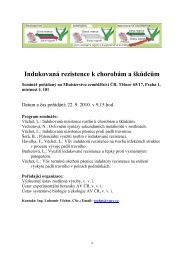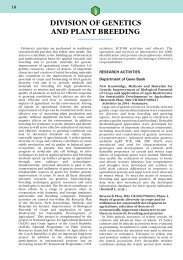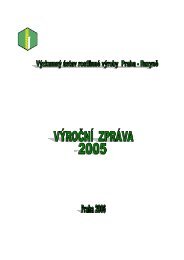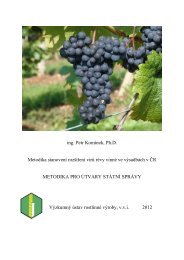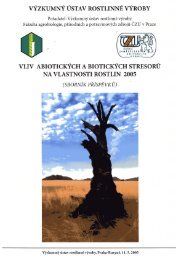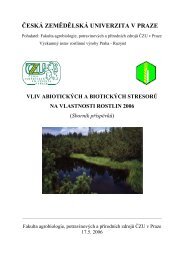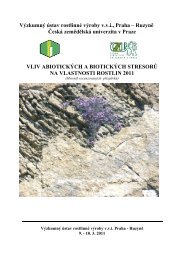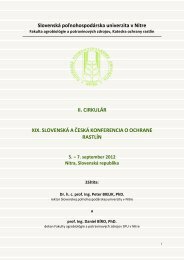00 ZLOM VURV 06 v roce 07
00 ZLOM VURV 06 v roce 07
00 ZLOM VURV 06 v roce 07
You also want an ePaper? Increase the reach of your titles
YUMPU automatically turns print PDFs into web optimized ePapers that Google loves.
19<br />
Fig. 2. Genetic distances within the spring wheat model collection<br />
DNA markers and field experiments with model<br />
“core” collections. Analyzed pedigree data of spring<br />
wheat collection were used to evaluate the genetic<br />
diversity of the collection, results were published in<br />
Czech J. Genet Plant Breed.The results confirmed that<br />
pedigree analyses could be used as one of the useful<br />
tools for development of “core” collections, i.e. such<br />
collections where extensive and reliable pedigree data<br />
are available.<br />
Model collections of spring wheat and oat (the same<br />
as in previous year) were sown and evaluated in field<br />
trials in two locations; winter barley was sown in three<br />
locations.The characterization of storage protein spectra<br />
by means of PAGE continued in 2<strong>00</strong>6.<br />
In both the spring wheat and winter barley model<br />
collection, DNA analyses were carried out using SSR<br />
markers and genetic distances between accessions were<br />
calculated. In spring wheat, we identified 26 clusters<br />
(composed of 2-5 accessions, with small genetic<br />
distances -0.<strong>06</strong> or less according to âeby‰ev), which<br />
represent 30.1% of the whole model collection (Fig. 2).<br />
When we used this level of genetic diversity, it was possible<br />
to reduce the size of the model collection by<br />
18.1%.The same approach in winter barley led to the<br />
size reduction by 34.1%. It can be concluded that the<br />
selection of genetically distant accessions to model<br />
collections was more effective in spring wheat.<br />
(Dotlaãil L., Nedomová L., Stehno Z., Faberová I.,<br />
Milotová J., Lei‰ová L., Dvofiáãek V., Oborn˘ J.,<br />
Hermuth J., âejka L., Poli‰enská I.)<br />
Possibilities of protein polymorphism<br />
application for identification and breeding<br />
of tested buckwheat (Fagopyrum esculentum<br />
Moench) cultivars (GA âR-521/04/P031)<br />
The project was aimed at the evaluation of protein<br />
polymorphism as an effective tool for the identification<br />
of common buckwheat accessions and studies of their<br />
mutual relations. Protein polymorphism of different<br />
plant parts (roots, leaves and achenes) showed<br />
high intra- and intervarietal variability only in the<br />
evaluation of the achene protein spectrum by<br />
SDS-PAGE. Protein polymorphism (including isozymes<br />
– esterases and total native protein) of the other plant<br />
parts was negligible and did not allow an individual<br />
approach to evaluation on this level. Higher protein<br />
polymorphism in different achene parts was confirmed<br />
in cotyledons in comparison with endosperm proteins.<br />
This high intravarietal polymorphism confirmed strict<br />
allogamy of common buckwheat. Electrophoretic<br />
visualization of tested protein fractions also confirmed<br />
high albumin and globulin content, its major importance<br />
in achene protein polymorphism and minimal<br />
content of prolamines. The albumin and globulin<br />
protein fraction of achenes was successfully used for<br />
more objective evaluation of bulked samples in the<br />
buckwheat world collection. Closer relations were<br />
found between accessions of neighbouring regions and<br />
between some original Czech and Slovak buckwheat<br />
accessions and accessions of China and Bhutan. Individual<br />
achene evaluation of four buckwheat varieties<br />
registered in the Czech Republic showed intervarietal<br />
differences in the frequency and coincidence of band<br />
proteins. It is possible to accept an opinion that the<br />
tested varieties were formed from a high number of<br />
variable genotypes which showed specific expression in<br />
tested varieties, nevertheless, slight spectral differences<br />
were detected in identical varieties between the tested<br />
years as well. For the future breeding application it will<br />
be necessary to reduce the wide genetic polymorphism<br />
of buckwheat population, which can be achieved only<br />
by direct characterisation of individual plants by means<br />
of molecular analysis and their isolated cultivation.<br />
The latest scientific papers offered a possibility of




